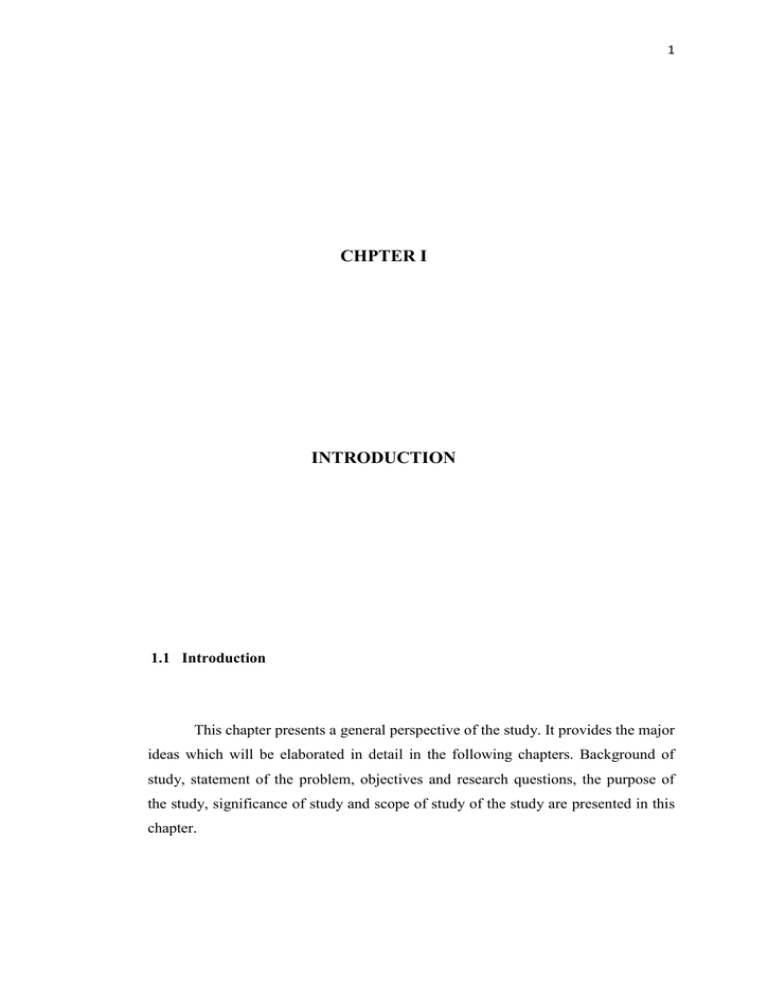CHPTER I INTRODUCTION
advertisement

1 CHPTER I INTRODUCTION 1.1 Introduction This chapter presents a general perspective of the study. It provides the major ideas which will be elaborated in detail in the following chapters. Background of study, statement of the problem, objectives and research questions, the purpose of the study, significance of study and scope of study of the study are presented in this chapter. 2 1.2 Background of Study Today using mother tongue comes as a useful tool which provides interaction between teacher and students in order to teach English. Studies show that using mother tongue can create a more cooperative atmosphere in the classroom. This is helpful as students and teacher must work together effectively and creatively in order to learn a foreign/second language (Schweers, 1999, Freeman, 2000, Nation, 2003). Mother tongue (First language/ L1) can be useful and helpful when the teachers use it appropriately. In spite of the public prevailing believes, using first language hinders comprehensive learning, it can improve learning the second language (Brown, 2000). Schweers (1999) persuades the English teachers to use mother tongue (L1) in teaching and even start their teaching with L1 because students feel secure and comfortable in the class. The use of L1 encourages them to show their feeling and express their experiences. Schweers (1999) in his study on EFL students and their 19 teachers in Spanish context shows that 88.7% of Spanish students who are learning English want to use L1 with second language (L2) coincidently in the classroom because they think that it helps them to learn English language better. Butzacamm (2003) claims that using L1 provides students to learn linguistic skills because they achieve those skills first with their mother tongue. He considers that the role of L1 is very important in teaching skills and sub skills. Furthermore, Miles (2004) supports using Bilingual instruction and rejects the monolingual because he believes “1- it is impractical, 2- the native teachers are not necessarily the best teachers and 3- exposure alone is not sufficient for learning”. The use of the 3 L1 can decrease the students‟ anxiety and increase the self confidence in target context to learn foreign language (Auerbach, 1993). According to popular methodology, Communicative language teaching, not only using L1should not avoided using in teaching language but also it is persuaded to help students or learners to learn language comprehensibly. In this method the student can use the L1 (mother tongue) to ask how to say what he wants to say and the teacher gives the second language equivalent kindly. The teacher focuses on cognition, affect and meaning (Chastain, 1988: 102,103). ESP (English for Specific Purposes) is also learner centred where the needs of students are the base of teaching methodology. Learning ESP is not limited to just the content of the knowledge in the classroom that will be taught for a day, nor for the syllabus to be carried out in the semester. It will be unnatural, because acquisition of the knowledge and skills cannot be separated from each other. In other words, the ESP learners learn general skills beyond their language learning and improving their skills. As a result of the developments in the world of education, Omar (1983) pointed out that local universities have adopted a policy which makes it compulsory for their students who have come through the national schools to take English as a compulsory subject at the undergraduate level. Students have to pass it in order to get their degrees. Hence Omar (1997) reported that most Malaysian students have difficulties to understand and comprehend the written and spoken English in universities. As the importance of using bilingual instruction in learning language and its effects on teaching and learning language over the past years, and also with regard to that it is not done research in learning the specific subject in bilingual instruction. 4 This research aims to examine the students‟ perception and determine effects of the bilingual instruction on students‟ learning of English for specific purposes. 1.3 Statement of the Problem Malaysia is a multilingual where English is used not only as a second language but also as the official language. In addition, with increasing the number of foreign students who are coming to Malaysia to study, English language comes as daily spoken language. The use of the English language is not limited to work places. Since 2003 Mathematics and Science are taught in English in primary and secondary schools in Malaysia (Veerasingam, 2009). In multilingual countries code switching is a common phenomenon. Two speakers can change their language in middle of speech. Besides, code switching can be effective as part of the teaching methodology when the teacher teaches important concepts or the students are confused to comprehend. Jorkovic (2006) states that the problem of misunderstanding of ESP can be caused by differences in language proficiency level among students (Fakharzadeh, 2009). Clark and Clark (1977) and Feild (2003) took into consideration this problem in psychology. They noted that the readers should regard syntactic and semantic as two useful different approaches to comprehend the texts. They argued that the readers confused when to use these two approaches (Maleki, 2008). 5 Comprehension problems happen when students fail to understand the content of those texts or lectures of the teachers. This problem happens due to the fact that they compare their first language (L1 or mother tongue) with the second language (L2). The similarities between L1and L2 can help the learners to understand and comprehend meaningfully (Bhela, 1999). These problems mostly occur to ESL (English as Second Language) learners, such as Malaysian students. These students have difficulties especially in associating the content with their pervious knowledge because they are familiar with specific vocabularies and structures of the expressions that are used in specific subjects (Carrel, 1987). Veerasingam (2009) points out that English is a foreign language for some students who live in suburbs and rural areas in Malaysia because the subjects are taught in Malay or Chinese at their schools. In addition, their parents do not speak in English at home. Therefore when they are admitted in the international university such as UTM thus will face a big challenge. For instance, according to a couple of interview content, management and human resource students who are studying specific subjects in English for specific purposes, say that they face difficulties such as inability to understand the content of the text. Besides, they may be confused by the foreign and new words in their textbooks. If carefully observed, these difficulties are mainly due to the monolingual (only English language used) instruction in teaching specific subjects. As given the example of insufficient second language, whether the bilingual instruction should be used to teach specific subject in an ESL classroom. As Maarof points out, our commonsense and the pragmatism of the classroom condition show us that the using L1 can be beneficial to understand and doing exercises among students. Veersingam (2009) states that the professional community of teachers believe the use of bilingual instruction is needed as learning tool in learning English. 6 Therefore this research is a systematic investigation in the practice of bilingual instruction to prepare some insight on the effects using the L1 in ESL classroom. 1.4 Purposes of the Study The purpose of this study is to examine students‟ perceptions of bilingual instruction and also to investigate the effects of bilingual instructions in the students‟ learning of specific subject in an ESL context. The research utilizes the qualitative research methodology and then supports with quantitative method. The instruments used to collect data are a set of interview questions and questionnaire. It seeks to describe how bilingual instruction can benefit the learners‟ learning in the ESP classroom. It is hoped that the findings of the research be applicable to help teachers to choose appropriate method to teach specific subject. This study aims to investigate whether using bilingual instruction enhance the students‟ comprehensibility and improve learning of specific subject the code switching can be as a source when they are learning specific subject for each student, because it helps them to realize clearly in form of communication. The study also attempts to describe the responses of the learners towards bilingual instruction in teaching and learning. Their responses will be helpful in finding out if bilingual instruction is preferable in improving their learning. Maybe some teachers use this method and teach in this way in their ESP classroom. Significantly the conclusion of the research would show that language teachers can teach specific subject with regard to profits of bilingual instruction in duration of the teaching and learning in their classroom. 7 1.5 Objectives of the Study The following research objectives get to: Examine students' perceptions of using bilingual instruction (using Bahasa Malaysia and English concurrently) in learning comprehensibly. Investigate whether the use of bilingual instruction promote students‟ learning. 1.6 Research Questions 1- What are the perceptions of students about using bilingual instruction? 2- Does the use of bilingual instruction promote students‟ learning of specific subject in English? 1.7 Research Hypothesis 1- Students have a positive attitude toward using bilingual instruction to learn comprehensibly. 2- Bilingual instruction has great influence on students‟ learning. 8 1.8 Significance of the Study Using bilingual instruction and trying to scare students from using their first language, we need to recognize that it is not using L1 itself but rather more use of L1 that is the problem in learning ESP. The findings of this research are important to help lecturers to consider the use of Bahasa Malaysia in Management and Human Resource program. And also provide to consider on the disputable issue of bilingual instruction in the ESP classroom. Findings of the current study would also illustrate how a second language can be acquired by utilizing the available L1 language knowledge as a useful tool in learning ESP. Significantly, this research provides an alternative method to teaching ESP in a second language classroom. The use of the bilingual instruction in teaching can or may be more effective than the use of monolingual to learn ESP. It focused on this idea that using bilingual instruction has an impact on students‟ learning. By approving that the presented research and findings can provide some insight for students, lecturers and syllabus designers to reflect and promote on the method of teaching ESP. 1.9 Scope of Research The respondents of this study were (N=50) undergraduate students of Management and Human Resource in UTM (Universiti Technologi Malaysia). The main purpose of this study is to determine the effects of using bilingual instruction in learning among respondents In addition, to identify Management and Human Resource undergraduate students‟ perceptions of using bilingual in learning. So to 9 explore these issues the participants will be interviewed and answered the questionnaires This study is limited to determine only the students‟ perceptions of using bilingual instruction in ESP classroom. The identified respondents (N=50) of the study consist of the Management and Human Resource undergraduate students. It used qualitative and quantitative method which includes questionnaire and interview to obtain data on the benefits and significant improvement in the ESP learning of the respondents after the use of the bilingual instruction in the ESL classroom. 1.10 Summary This chapter has presented the background of study, some problems and reasons which caused to carry out this research. Then it stated objectives of the study and also introduced the respondents of the study. The next chapter will discuss some related theories and review the literature.






